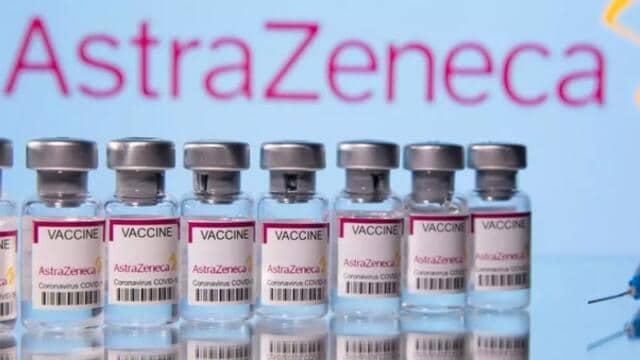Residents 40+ in Mississauga and Brampton can now get the AstraZeneca vaccine
Published April 18, 2021 at 11:38 pm

Ontario will start offering the Oxford-AstraZeneca vaccine to those aged 40 and over starting on Tuesday, the province announced Sunday following days of mounting pressure to lower the minimum age.
The province had previously stuck to the National Advisory Committee on Immunization’s recommendation to only offer the AstraZeneca shot to those 55 and over due to a slightly elevated risk of an extremely rare blood clot disorder.
But as hospitalizations surged to unprecedented levels in Ontario and AstraZeneca vaccines sat in pharmacy refrigerators, Health Minister Christine Elliott’s office confirmed the plan to make the shots available to more residents.
“Based on current supply, Ontario will begin offering the AstraZeneca COVID-19 vaccine to individuals aged 40 and over at pharmacy and primary care settings across the province effective Tuesday,” Alexandra Hilkene said in an email on Sunday evening.
Hours earlier, Elliott’s federal counterpart told a news conference that such a move was well within the provinces’ jurisdiction.
“NACI provides advice to provinces and territories,” Health Minister Patty Hajdu said. “They can adjust their use for AstraZeneca as per their desire and the advice from their own public health authorities and medical expertise.”
She noted that Health Canada has licensed the AstraZeneca shot for use in people over the age of 18.
“NACI continues to review the advice on AstraZeneca use and will have updated guidance in the very near future,” Hajdu added.
Anthony Dale, president and CEO of the Ontario Hospital Association, tweeted that there is “‘surplus supply at risk of expiring.”
Many Ontario physicians took to social media to express their frustration with the province’s lack of action on the issue.
“Pharmacies, listen up. DO NOT WASTE A SINGLE DOSE OF THE AZ VACCINE. Explain the risk and obtain informed consent to administer to people under age 55,” Dr. Brian Goldman said in a tweet Sunday.
Dr. Irfan Dhalla, vice-president of Unity Health Toronto, agreed.
“It’s hard to imagine the provincial government coming after pharmacies or family doctors for using AZ in people (under) 55,” he tweeted.
Later, he praised Elliott’s decision to unlock some of the AstraZeneca vaccines, and urged the province to send even more to COVID-19 hot spots.
Steven Del Duca, who heads up the Liberal party in the province, agreed.
“Doug Ford must release the AstraZeneca vaccine from pharmacy freezers and get it into the arms of anyone over 18 in a hot spot,” he tweeted Sunday. “(Patty Hajdu) was clear: there is nothing stopping him from getting shots into arms.”
The calls to lower the threshold for the AstraZeneca vaccine extended beyond Ontario’s borders.
“It sounds like Alberta is having trouble using its AstraZeneca. Lower the minimum age; Gen X can help!” Lisa Young, a political science professor at the University of Calgary, tweeted this week.
Dr. Deena Hinshaw, the province’s chief medical officer of health, said Saturday that the province planned to make a decision around age ranges for AstraZeneca eligibility “in the near future.”
Some have been hesitant to accept the AstraZeneca vaccine due to a very rare blood clotting condition, which has thus far affected two Canadians.
More than 700,000 doses of the AstraZeneca vaccine have been administered in this country.
The global frequency of the blood clot disorder, known as vaccine-induced immune thrombotic thrombocytopenia, or VITT, has been estimated at about one case in 100,000 to 250,000 doses.
The risk of developing blood clots due to COVID-19 is much higher, and experts say people should accept the first vaccine they’re offered.
Meanwhile, the federal government announced Sunday that it was mobilizing its own resources and co-ordinating with lesser-hit provinces to send health-care workers and other support to help Ontario as it battles record-breaking COVID-19 numbers.
It wasn’t immediately clear how the Ontario government would respond to Ottawa’s offer.
Hospitalizations and admissions to intensive care units continued to reach record heights in the province, which reported 4,250 new COVID-19 infections in the last 24 hours.
Ontario announced a number of new restrictions to quell the skyrocketing numbers, but has faced pressure to roll back limits on outdoor activities, which critics have said will do little to stop the spread.
Meanwhile, data released by Canada’s chief public health officer indicated the average daily number of hospitalizations and deaths in the country jumped by more than 30 per cent between April 9 and 15 compared to the week before.
The latest national figures showed an average of 3,428 people with COVID-19 were being treated in Canadian hospitals each day during the most recent seven-day reporting period, representing a 34 per cent increase over the week before.
An average of 41 people died each day during the same stretch, which is 38 per cent higher than the previous week.
Chief Public Health Officer Dr. Theresa Tam said cases, test positivity rates and intensive care admissions are all rising as Canada battles a wave of COVID-19 that is driven by more contagious virus variants.
Quebec, meanwhile, reported more than 1,300 new infections in the past 24 hours.
Prince Edward Island recorded three new cases, while Nova Scotia logged seven and New Brunswick added 10.
Farther west, Manitoba recorded 170 new cases of the virus and one added death, while Saskatchewan counted 289 new cases and one death.
Alberta, which is currently dealing with the highest rate of COVID-19 per capita in Canada, reported 1,516 new cases of the virus on Sunday and three more deaths.
As of Saturday night, Ontario’s rate of active COVID-19 cases was 276 per 100,000, compared to 391 per 100,000 in Alberta.
This report by The Canadian Press was first published April 18, 2021.
– with files from Morgan Lowrie in Montreal and Rob Drinkwater in Edmonton.
Nicole Thompson, The Canadian Press
INsauga's Editorial Standards and Policies








